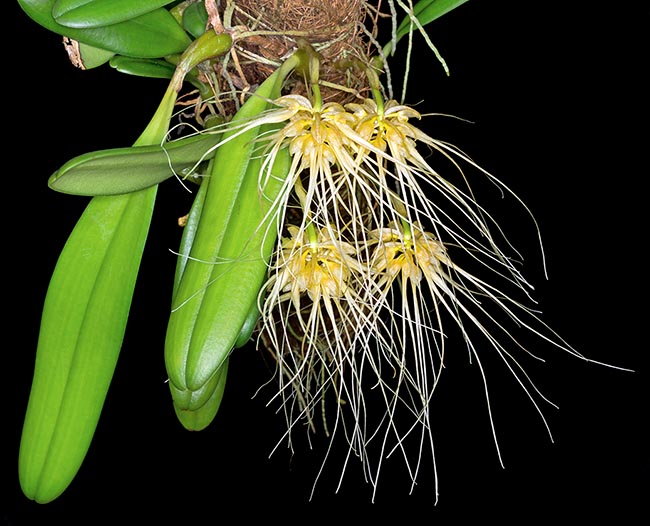Family : Orchidaceae

Text © Pietro Puccio

English translation by Mario Beltramini

Bulbophyllum vaginatum is a miniature orchid, sturdy and easy to grow, native to south-eastern Asia. The juice obtained from the roasted fruits is traditionally used in Malaysia against the earache © Giuseppe Mazza
The name of the genus is the combination of the Greek substantives “βολβός” (bolbos) = bulb and “φύλλον” (phyllon) = leaf, with reference to the leaves growing at the apex of the pseudobulbs; the specific name is the Latin adjective “vaginatus, a, um” = provided of sheath, with reference to the bracts present on the floral scape.
The Bulbophyllum vaginatum Rchb. f. (1861) is an epiphytic species forming dense tufts wrapping whole branches with oblong pseudobulbs, about 3 cm long, spaced of 3-5 cm on a creeping rhizome rooting at the nodes and provided of a unique oblong leaf with emarginate apex, 5-15 cm long and 1,5-2,5 cm broad, coriaceous, of intense green colour. Umbelliform inflorescence from the base of the pseudobulb, on an about 10 cm long peduncle provided of several bracts, bearing up to 15 flowers of pale yellow colour. Ovate dorsal sepal with ciliate margins, 0,3-0,6 cm long, lanceolate lateral sepals with long filiform appendage, 4-7 cm long, ciliate at the base, oblong petals, 0,2-0,3 cm long, ciliate, oblong labellum, 0,2-0,3 cm long, of of orange yellow colour and run by two keels. It reproduces by seed, in vitro, and by division at the vegetative restart, with each section provided of at least 3-4 pseudobulbs. Vigorous and easy to cultivate miniature orchid that in nature blooms in mass after an intense rain, requires a slightly shaded position, medium-high temperatures, 24-35 °C, high humidity, 80-85%, and constantly moving air. The waterings must be regular and abundant, but allowing the substratum to dry up before giving water again, utilizing rain water, demineralized or by reverse osmosis. Monthly fertilizations preferably with a hydrosoluble balanced product, with microelements, at ¼ the dosage shown on the package. It is mounted on trunks, bark, rafts of cork or of arborescent ferns roots, with some sphagnum at the base of the plant to keep the humidity if the cultivation ambient is rather dry, or in baskets fairly wide, to allow the pseudobulbs to expand freely, with draining and aerated compost that can be formed by bark fragments and medium sliced charcoal. Transplants and repottings are to be done, only is strictly necessary, at the vegetative restart signalled by the emission of the new roots.
The juice obtained from the roasted fruits is utilized in Malaysia against earaches.
The species is reported in the appendix II of CITES (species whose trade is internationally ruled).
Synonyms: Cirrhopetalum vaginatum Lindl. (1830); Cirrhopetalum caudatum Wight (1851); Cirrhopetalum stramineum Teijsm. & Binn. (1862); Phyllorkis vaginata (Lindl.) Kuntze (1891); Cirrhopetalum whiteanum Rolfe (1895); Bulbophyllum whiteanum (Rolfe) J.J.Sm. (1912).
→ For general notions about ORCHIDACEAE please click here.
